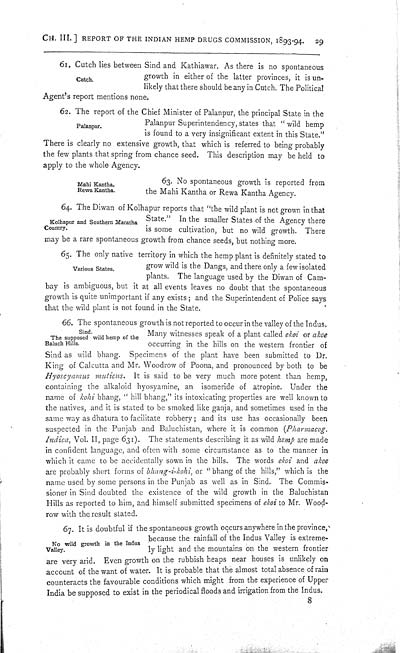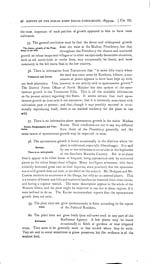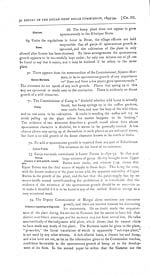Download files
Individual page:
Thumbnail gallery: Grid view | List view

CH. III.] REPORT OF THE INDIAN HEMP DRUGS COMMISSION, 1893-94. 29
Cutch.
61. Cutch lies between
Sind and Kathiawar. As there is no spontaneous
growth in either of the
latter provinces, it is un-
likely that there should be any in Cutch. The
Political
Agent's report mentions
none.
Palanpur.
62. The report of the
Chief Minister of Palanpur, the principal State in the
Palanpur Superintendency,
states that "wild hemp
is found to a very insignificant extent in this
State."
There is clearly no
extensive growth, that which is referred to being probably
the few plants that spring from chance seed. This description may
be held to
apply to the whole Agency.
Mahi Kantha.
Rewa Kantha.
63. No spontaneous growth
is reported from
the Mahi Kantha or Rewa Kantha Agency.
Kolhapur and Southern
Maratha
Country.
64. The Diwan of Kolhapur
reports that "the wild plant is not grown in that
State." In the smaller
States of the Agency there
is some cultivation, but no wild growth. There
may be a rare spontaneous
growth from chance seeds, but nothing more.
Various States.
65. The only native
territory in which the hemp plant is definitely stated
to
grow wild is the Dangs, and
there only a few isolated
plants. The language used by the Diwan of Cam-
bay is ambiguous, but it at
all events leaves no doubt that the spontaneous
growth is quite unimportant if any exists; and the Superintendent
of Police says
that the wild plant is not found in the State.
Sind.
The supposed wild hemp of theBaluch Hills.
66. The spontaneous
growth is not reported to occur in the valley of the
Indus.
Many witnesses speak of a
plant called ekoi or akoe
occurring in the hills
on the western frontier of
Sind as wild bhang.
Specimens of the plant have been submitted to Dr.
King of Calcutta and Mr. Woodrow of Poona, and pronounced by both
to be
Hyoscyamus muticus. It is said to be very much more potent
than hemp,
containing the alkaloid hyosyamine, an isomeride of atropine. Under
the
name of kohi bhang, "hill bhang," its intoxicating
properties are well known to
the natives, and it is stated to be smoked like ganja, and
sometimes used in the
same way as dhatura to facilitate robbery; and its use has
occasionally been
suspected in the Punjab and Baluchistan, where it is common
(Pharmacog.
Indica, Vol. II, page 631). The statements describing it as
wild hemp are made
in confident language, and often with some circumstance as to the
manner in
which it came to be accidentally sown in the hills. The words
ekoi and akoe
are probably short forms of
bhang-i-kohi, or "bhang of the hills," which is the
name used by some persons in the Punjab as well as in Sind. The
Commis-
sioner in Sind doubted the existence of the wild growth in the
Baluchistan
Hills as reported to him, and himself submitted specimens of
ekoi to Mr. Wood-
row with the result stated.
No wild growth in the
Indus
Valley.
67. It is doubtful if the
spontaneous growth occurs anywhere in the province,
because the rainfall of the
Indus Valley is extreme-
ly light and the mountains on the western frontier
are very arid. Even growth
on the rubbish heaps near houses is unlikely on
account of the want of water. It is probable that the almost total
absence of rain
counteracts the favourable conditions which might from the
experience of Upper
India be supposed to exist in the periodical floods and irrigation
from the Indus.
8
Set display mode to: Large image | Zoom image | Transcription
Images and transcriptions on this page, including medium image downloads, may be used under the Creative Commons Attribution 4.0 International Licence unless otherwise stated. ![]()
| India Papers > Medicine - Drugs > Report of the Indian Hemp Drugs Commission, 1894-1895 > Volume I > (50) Page 29 |
|---|
| Permanent URL | https://digital.nls.uk/74574168 |
|---|---|
| Description | Chapter Three, cont. |
| Description | [Volume 1]: Report. |
|---|---|
| Attribution and copyright: |
|




